Solar PEIS: One More Virtual Meeting on California and Nevada

February 10, 2023 - The Solar Programmatic Environmental Impact Statement (Solar PEIS) scoping deadline has been moved to March 1. The Bureau of Land Management (BLM) recently put out a press release stating that, “due to substantial public interest, the Bureau of Land Management has added one more virtual session to its series of public scoping meetings seeking input on potential changes to its solar energy program” on February 14. The BLM stated that “the BLM is especially interested to hear comments related to solar energy development in southern California and southern Nevada, given specific expressed interest in the program in those areas,” indicating huge concern over potential changes to the Desert Renewable Energy Conservation Plan, as well as controversial resource conflicts in southern Nevada.
Idaho Bureau of Land Management Public Meetings on Developing Public Lands For Renewable Energy
February 9, 2023 - Via email from the Bureau of Land Management state office, register here: https://jubengineers.zoom.us/meeting/register/tZwuduivpz0pG9DoKgdE7k6hqnzqKsHaNXxz
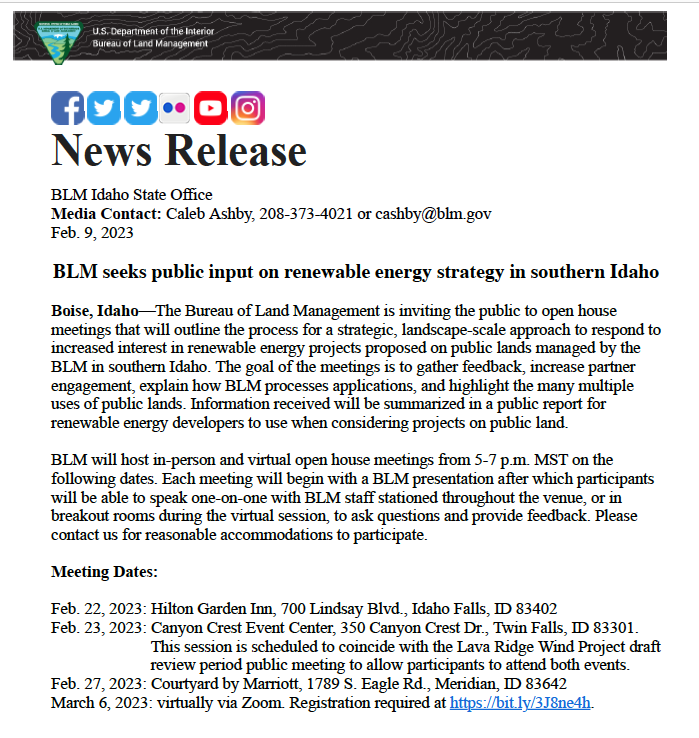

See also Lava Ridge Wind Project.
2023 Solar Programmatic Environmental Impact Statement Update
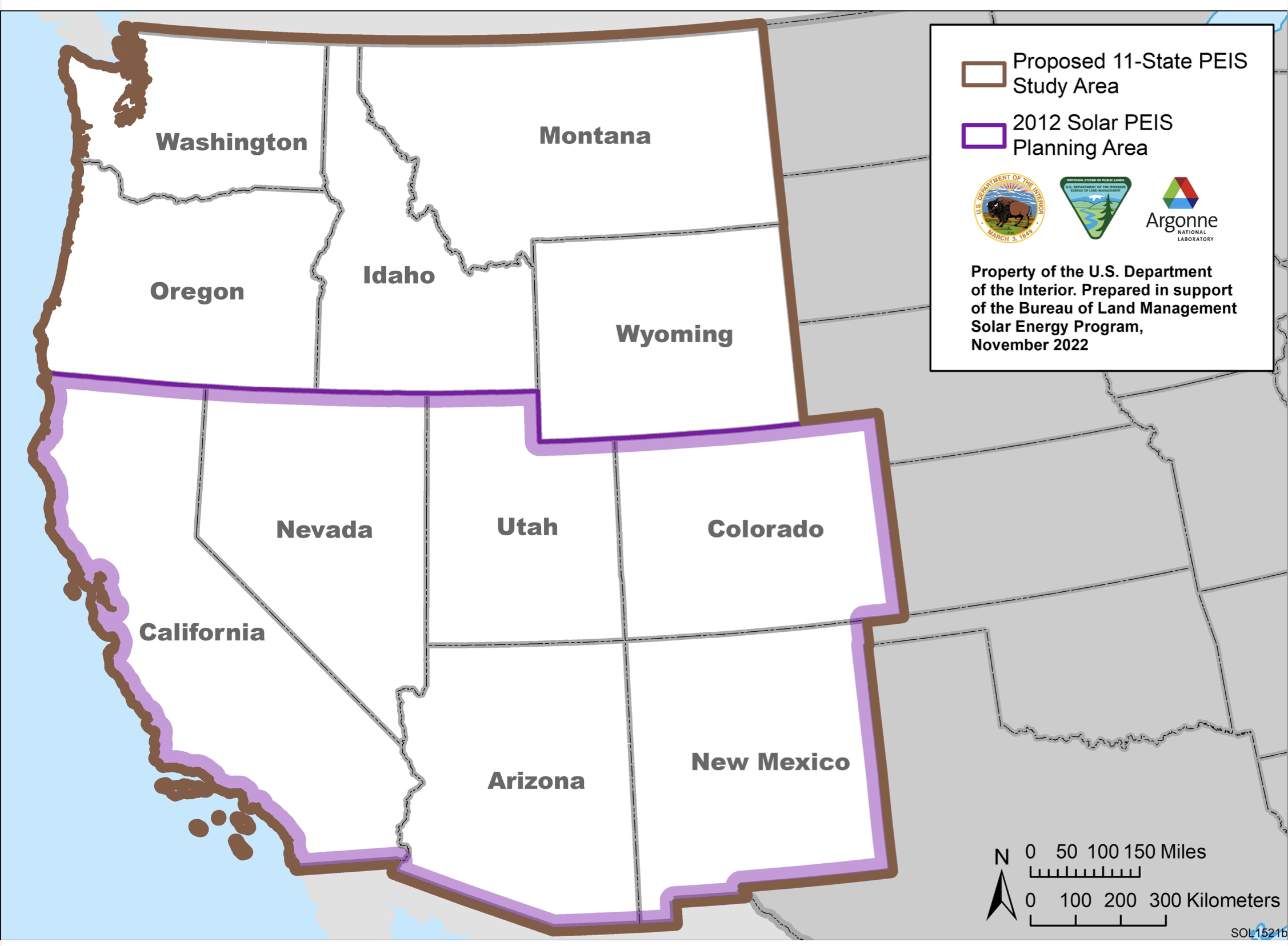
January 10, 2023 - The Bureau of Land Management (BLM) is developing an updated plan to guide solar energy development on public lands through an updated Solar Programmatic Environmental Impact Statement (Solar PEIS), which will "help accelerate and continue momentum for the clean energy econom" in a statement issued by BLM. The 2012 Solar PEIS will be expanded to all western states, opening up the vast sagebrush habitats to utility-scale solar development.
The comment deadline is February 6, 2023. Stay tuned, Basin and Range Watch will be writing extensive comments, and will provide summary points to write in your own public comments.
In California, the Desert Renewable Energy Conservation Plan (DRECP) may need to be updated as well in order to conform to the updated Solar PEIS which overlaps. We will be commenting on this.
Important links: https://eplanning.blm.gov/eplanning-ui/project/2022371/570
Register for virtual meetings at https://www.blm.gov/2023-solar-programmatic-environmental-impact-statement
The Bureau of Land Management is holding a series of public scoping meetings to solicit feedback on the recently announced programmatic environmental impact statement for the BLM’s utility-scale solar energy planning. The BLM is considering updates to its 2012 Western Solar Plan that included six southwestern states—Arizona, California, Colorado, Nevada, New Mexico, and Utah—and is seeking comment regarding expanding its solar planning to include five additional states: Idaho, Montana, Oregon, Washington, and Wyoming.
Below is meeting information:
Virtual: January 12, 2023, 12:30 pm – 3:30 pm Mountain Standard Time. Pre-registration is required. Click below to register for this meeting:
https://argonne.zoomgov.com/meeting/register/vJItce2prDItErl7Pg9WfX0W7I7sh7sI3Ck. After registering, you will receive a confirmation email containing information about joining the meeting.
Washington, D.C.: January 13, 2023, 9 a.m. – 1 p.m. Eastern Standard Time, at the Stewart Lee Udall Building, 1849 C Street, N.W., Washington, D.C. 20240, in the Yates Auditorium. Please enter at on C Street. Nearest Metro is Farragut West (orange and blue lines) and Farragut North (red line). No parking is available on-site.
Sacramento, CA: January 18, 2023, 10 a.m.-2 p.m. Pacific Standard Time, at the Courtyard by Marriott Sacramento Cal Expo, 1782 Tribute Road, Sacramento, CA, 95815, in Golden State Rooms AB. Parking is complimentary for attendees.
Reno, NV: January 19, 2023, 3-7 p.m. Pacific Standard Time, at the Reno-Sparks Convention Center, 4590 South Virginia Street, Reno, NV 89502, in Room A-3 (access through north entrance parking lot). Parking is complimentary for attendees.
Phoenix, AZ: January 24, 2023, 3-7 p.m. Mountain Standard Time, at the Southeast Regional Library, 775 N. Greenfield Road, Gilbert, AZ 85234, in the Shakespeare Assembly Room. Parking is complimentary for attendees.
Albuquerque, NM: January 26, 2023, 3-7 p.m. Mountain Standard Time, at the Crown Plaza located at 1901 University Boulevard NE, Albuquerque, NM 87102. Parking is complimentary for attendees.
Virtual: February 13, 2023,12:3-3:30 p.m. Mountain Standard Time. Pre-registration is required. Click below to register for this meeting:
https://argonne.zoomgov.com/meeting/register/vJIsdOGhqTsoH695-CQKbVk2QMr_XxPikfo.
After registering, you will receive a confirmation email containing information about joining the meeting.
This is insufficient. We need to ask for in-person meetings in Blythe, Los Angeles, Pahrump, Las Vegas, and other cities were the 2012 Solar PEIS has heavily impacted communities and public lands in the California Desert and Nevada Mojave Desert.
The Notice of Intent to update the BLM’s 2012 solar programmatic environmental impact statement was published in the Federal Register on December 8, 2022, with interested parties invited to submit written feedback or to participate in one of the following upcoming in-person or virtual public scoping meetings.
The public comment period will remain open until February 6, 2023, or 15 days after the last public scoping meeting, whichever is later. For more information on these meetings and to view the Notice of Intent, visit the BLM’s ePlanning web site at https://eplanning.blm.gov/eplanning-ui/project/2022371/570
Park or Energy Development Zone -- Can You Tell the Difference?
July 13, 2015 - Basin and Range Province, Nevada - One photo is from the Dry Lake North Solar Energy Zone, one is from the new Basin and Range National Monument, and one is from the Gold Point Solar Energy Zone, all in the Great Basin Desert in Nevada. Is the new monument (with special protection) more beautiful than the Solar Energy Zones (subject to grading and bulldozing), or is the entire region all spectacular? Why does the Bureau of Land Management believe the Solar Energy Zones have little conservation value? All Great Basin Desert has conservation value in our opinion.

^Overlooking the Gold Point Solar Energy Zone with Joshua trees (Yucca brevifolia).
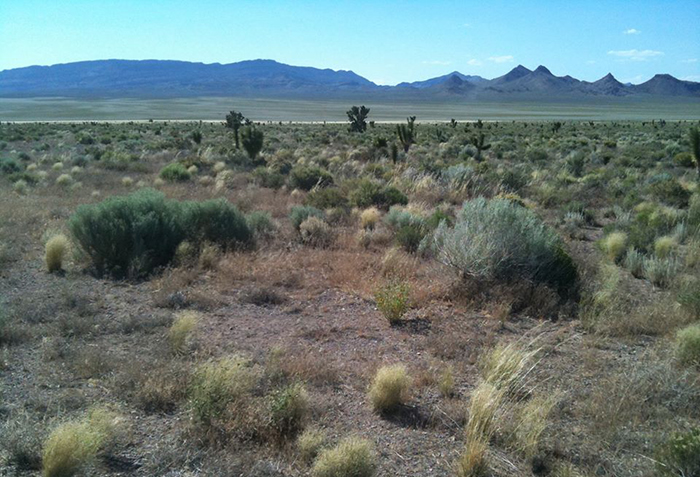
^Dry Lake North Solar Energy Zone with native rice grass bunches (Stipa hymenoides), needle-and-thread grass (S. comata), and Joshua trees.

^Basin and Range National Monument (photo from Protect Basin and Range website).
Environmental Assessments for Projects in Dry Lake Solar Energy Zone Available for Review
December 11, 2014 - On December 8th, the Bureau of Land Management (BLM) announced the availability of Environmental Assessments for three proposed projects in the Dry Lake Solar Energy Zone (SEZ). The Environmental Assessments are available through the BLM Southern Nevada District Office Renewable Energy web page. The Environmental Assessments will be open for public comment through January 8, 2015.
Streamlined Environmental Review for Dry Lake Solar Energy Zone
December 5, 2014 - The Bureau of Land Management (BLM) today released three Environmental Assessments (EAs) for solar projects on the Dry Lake Solar Energy Zone in Clark County, Nevada. Contrary to former policy where large-scale solar energy projects were reviewed with a more detailed and rigorous Environmental Impact Statement (EIS) under National Environmental Policy Act (NEPA) guidelines, this new streamlining would allow developers to get away with reduced and quicker review with meager EAs, a major step down in environmental review.
The projects, which propose to generate a combined total of 480 megawatts of electricity on 3,083 acres within the Dry Lake Solar Energy Zone, are the first to reach this stage of permitting under the Western Solar Plan. The EA reviews are completed in less than six months, compared to reviews under the previous project-by-project system with EISs that took on average 18 to 24 months to complete.
BLM stated that the reviews also include consideration of the first offsite mitigation requirements for Solar Energy Zone projects. This means mitigation will not even help restore and protect Dry Lake Valley desert lands, but will be off site somewhere else.
The news release goes on to say: "Secretary Jewell’s landscape approach shifts the focus from determining mitigation on a permit-by-permit basis, to a strategic and landscape-level perspective, where mitigation can be identified through regional strategies and land use planning." When mitigation is not based in the actual valley where solar development takes place, we lose valuable natural resources to unproven offsite mitigation which is often undetermined and vague in our experience working with utility-scale renewable energy projects.
“Today’s announcement delivers on the promise of the Western Solar Plan and the landscape approach to solar development,” said Michael L. Connor, Deputy Secretary of the Department of the Interior. “Through advance planning and stakeholder outreach, the BLM has achieved better environmental outcomes as well as a faster, more streamlined process for industry. It is a win-win approach for responsible solar development on our public lands.” We think any development and bulldozing of desert ecosystems is a lose scenario for the environment, while industry benefits unfairly as multiple-use public lands are sacrificed to corporate interests. This is not a "win-win" scenario.
The Dry Lake Solar Energy Zone proposals were submitted for consideration by the three successful bidders to a competitive auction held by the BLM on June 30, 2014. The auction, which generated more than $5.8 million in high bids, was part of a competitive leasing process.
Invenergy Solar Development, LLC proposes to construct a 130 megawatt (MW) solar photovoltaic power generating facility on approximately 715 acres. Playa Solar, LLC (a subsidiary of First Solar) is proposing to construct a solar photovoltaic generation facility of up to 200 megawatts on approximately 1,700 acres. NV Energy proposes to construct a 150 MW solar photovoltaic power generating facility on approximately 660 acres in the Dry Lake Solar Energy Zone.
The Environmental Assessments will be open for public comment through January 8, 2015. The BLM Las Vegas Field Office will host an open house on December 10 from 6 to 8 p.m. at 4701 North Torrey Pines Drive, Las Vegas. Documents available for public review are Dry Lake SEZ Parcel 1 (http://on.doi.gov/1scQTb6), Dry Lake SEZ Parcels 2,3 and 4 (http://on.doi.gov/1vwugyD) and Dry Lake SEZ Parcels 5 and 6 (http://on.doi.gov/1w72dJJ).
For more information on the public review process, please contact Greg Helseth, Renewable Energy Project Manager, at 702-515-5173, or ghelseth@blm.gov.
See the news release here:
http://www.blm.gov/nv/st/en/info/newsroom/2014/december/southern_nevada__blm.html
Bids Come In at Auction for Dry Lake Solar Energy Zone
July 3, 2014 - North Las Vegas, NV - After approval of the federal Programmatic Solar Environmental Impact Statement detailing several Solar Energy Zones in the Southwest states, on May 30, 2014, the Bureau of Land Management Nevada State Office published a Notice of Competitive Auction for Solar Energy Development on Public Lands in Nevada. This notice announces that the BLM will hold an oral auction on June 30, 2014, at the City of North Las Vegas Council Chambers, 2250 Las Vegas Blvd, North Las Vegas, NV 89030, to select high bidders and preferred applicants to submit right-of-way applications for solar energy projects within the Dry Lake Solar Energy Zone. The BLM is offering up to approximately 3,083 acres of public land in 6 parcels within the SEZ.
Attendees at the auction report that several bids came in. Each parcel had at least two active bidders and resulted in bids totaling $5,835,000. Apparently five active bidders were present. It was not clear from the names given who the bidders represented.
Bureau of Land Managment Announces Competitive Bid for Dry Lake Solar Energy Zone in Nevada
June 2, 2014 - As part of the federal solar energy Programmatic Environmental Impact Statement, on May 30, 2014, the Bureau of Land managment (BLM) Nevada State Office published a Notice of Competitive Auction for Solar Energy Development on Public Lands in the State of Nevada. This notice announces that the BLM will hold an oral auction on June 30, 2014, at the City of North Las Vegas Council Chambers, 2250 Las Vegas Blvd, North Las Vegas, NV 89030, to select high bidders and preferred applicants to submit right-of-way applications for solar energy projects within the Dry Lake SEZ. The BLM is offering up to approximately 3,083 acres of public land in 6 parcels within the SEZ.
Existing regulations authorize the BLM to determine whether competition exists among Right-of-Way applications filed for the same facility or system. The regulations also allow the BLM to resolve any such competition by using competitive bidding procedures. The BLM will use a competitive sealed and oral bid process to select preferred applicants to submit ROW applications and plans of development for solar energy development in the Dry Lake SEZ. Details on fee and bid requirements are provided in the notice. The bid statement format and a complete description of the bid process are contained in an Invitation for Bids package (see the Dry Lake Competitive Leasing page of the BLM's Solar Energy Program Web site).
For more information visit the BLM Solar Energy Program Web Site at http://blmsolar.anl.gov
Salazar Signs Record of Decision Approving Final Solar PEIS
October 12, 2012 - Secretary Ken Salazar of the Department of Interior today signed the Record of Decision approving the Solar Programmatic Environmental Impact Statement. He is in Las Vegas, accompanied by Senator Harry Reid (D-NV), Nevada Bureau of Land Management State Director Amy Lueders, and the President of the University of Nevada at Las Vegas Neal Smatresk. See the announcement on the Department of Interior page >>here.
The announcement starts: "As part of President Obama’s all-of-the-above energy strategy to expand domestic energy production, Secretary of the Interior Ken Salazar today finalized a program for spurring development of solar energy on public lands in six western states. The Programmatic Environmental Impact Statement (PEIS) for solar energy development provides a blueprint for utility-scale solar energy permitting in Arizona, California, Colorado, Nevada, New Mexico and Utah by establishing solar energy zones with access to existing or planned transmission, incentives for development within those zones, and a process through which to consider additional zones and solar projects."
The Solar PEIS sets aside 17 Solar Energy Zones (SEZs) totaling about 285,000 acres of public lands that will serve as priority areas for commercial-scale solar development, with the potential for additional zones through ongoing and future regional planning processes. Basin and Range Watch has been to most of these zones and they are prime desert ecosystems that should not be scraped and fragmented for solar power, especially when truly "smarter" alternatives exist such as degraded lands and the built environment.
What has really angered even those environmentalists who supported the PEIS are the additional 19 million acres of "variance" areas that will be opened to solar development on a case by case basis.
“We are proud to be a part of this initiative to cut through red tape and accelerate the development of America’s clean, renewable energy,” said Secretary of Energy Steven Chu. “There is a global race to develop renewable energy technologies—and this effort will help us win this race by expanding solar energy production while reducing permitting costs.”
But "cutting through red tape" is actually cutting through the democratic process of listening to the citizens who made comments against this large development of our last wild lands. The National Environmental Policy Act (NEPA) signed in 1970 that protects the valuable resources owned by the public on millions of acres of desert, mountain, grassland, and other natural lands has been progressively weakened, and the very fast review and signing of this massive plan while ignoring alternatives and many sensitive resources, again knocks another leg out from under NEPA.
And in an apparent nod to the fossil fuel industry, the Interior statement ends by saying:
"Today’s action is in line with the President’s direction to continue to expand domestic energy production, safely and responsibly. Since President Obama took office, domestic oil and gas production has increased each year, with domestic oil production at an eight-year high, natural gas production at an all-time high, and foreign oil imports now accounting for less than 50 percent of the oil consumed in America – the lowest level since 1995."
The Solar PEIS is no longer a plan to mitigate Climate Change, but a vast privatization of public lands enjoyed by recreationists, hunters, fishermen, off-highway vehicle enthusiasts, wildlife watchers, wild horse and burro supporters, photographers, campers, birders, and many others who use these lands.
Final Solar PEIS Relased
July 24, 2012 - The Final Programmatic Environmental Impact Statement for Solar Energy Development in Six Southwestern States (Final Solar PEIS) is now available on the Internet at the project Web site (http://solareis.anl.gov). The Bureau of Land Management (BLM) and the Department of Energy considered all comments submitted on the Draft Solar PEIS and the Supplement to the Draft Solar PEIS during preparation of the Final Solar PEIS, and have made many changes in response to those comments.
To submit feedback, contact the Solar Energy Development PEIS webmaster at solareiswebmaster@anl.gov.
We believe the final document is actually weaker in many ways than the earlier versions, especially in protection for the Desert tortoise (Gopherus agassizii). Although some of Ivanpah Valley is excluded from solar development, other areas to the north are open in a variance process where developers may submit project applications as in the status quo, again not providing protection for important genetic flow corridors across the tortoise populations and between Recovery Units. Instead of outright excluding these tortoise connectivity areas as recommended by US Fish and Wildlife Service, the present document merely "discourages" solar development in these areas.
Applicants would have to meet with Bureau of Land Management and plan how their proposed project could be minimized to lessen disturbance of tortoise habitat and genetic flow. But again, this type of piecemeal development only eats away at prime tortoise populations. No guidance on the width of a tortoise connectivity corridor was stated.
Variance areas were reduced from 21 million acres of public land open to solar development, to 16 million acres. Still most of the wide open spaces of the Southwest.
Some Solar Energy Zones were reduced in acreage, such as Amargosa and Dry Lake North in Nevada, but in a haphazard way. Most public comments, including those by Basin and Range Watch, were ignored.
See Mojave Desert Blog for an excellent summation of the release:
http://www.mojavedesertblog.com/2012/07/desert-solar-policy-codifies-status-quo.html
Our Comments on the Supplement to the PEIS
January 27, 2012 - >>here
Meeting for Supplement to PEIS Draws Large Audience in Las Vegas

December 3, 2011 - The first public meeting held to gather comments for the Supplement to the solar Programmatic Environmental Impact Statement took place in Las Vegas, Nevada, on November 30, 2011. The room was full of interested members of the public, solar industry representatives, and many Bureau of Land Management personnel from Washington DC and the local field office. A Department of Energy representative was also present.
Mark Spencer, the BLM Southern Nevada Field Office Manager told the audience that nearly 81,000 comments had been received, and this Supplement tried to address some of the concerns raised from the first draft of the PEIS. The deadlines for comments is January 27, 2012.
The Supplement removes some Solar Energy Zones, from 24 to 17. Boundaries on eight other SEZs were adjusted, and at present the current zones would occupy 285,417 acres of desert.
How to get transmission lines to the remote SEZs was also addressed more, as was the Variance Process for siting new projects outside of Solar Energy Zones on BLM land. New SEZs can be proposed. Additional analysis of environmental impacts was incorporated, much from the detailed comments by environmental groups and other commenters.

Shannon Steward from BLM in Washington DC gave a more detailed PowerPoint presentation of the changes in the Supplemental PEIS. She said the slides would be made available to the public in a month or so on the PEIS website.
Some new concerns came up:
1. BLM has 79 first-in-line applications for 33,300 MW on 685,000 acres and these will continue to be processed (they are not in zones). These are grandfathered in. There are 20 in California, 25 in Nevada, 31 in Arizona, 3 in New Mexico, and none in Colorado and Utah. There are 13 priority projects for 2011 and 2012. This is in addition to the solar energy zones. We believe this is too much public land devoted to one use.
2. Faster and easier permitting will occur in the Solar Energy Zones, for National Environmental Policy Act, Endangered Species Act, National Historic Preservation Act, Tribal consultation, and public involvement. Incentives for siting inside the zones will include regional mitigation planning, transmission analysis, and economic incentives -- lower megawatt capacity fees for example.
3. New SEZs will be identified at the BLM state or district office level. Petitions for new zones can be submitted to BLM State Directors with supporting documentation, and the process should take 12-18 months start to finish. BLM wants many new zones in Clark County, Nevada (big red flag, this is a tortoise dense zone). BLM in Colorado also wants to identify new SEZs. Yet no pubic meetings were scheduled for Colorado. Steward told the audience, "Want to find what is interesting to developers first, then do environmental analysis."
4. Exclusion zones include Critical Habitat, Wilderness Areas, and other management areas totaling 77.6 million acres. But Special Recreation Management Zones are back on the table.
5. Variance Areas of public land outside the SEZs include about 20 million acres where applications will be reviewed on a case-by-case basis. Cost recovery will be requested. Options to combine federal and non-federal land will be looked at, as well as disturbed lands. Presence of conflicts, such as tortoise density, will also be considered. These applications will undergo public scoping.
6. Mitigation plans have been deferred. Adaptive management and monitoring plans will be developed. So how can we comment on them? BLM will do more resource surveys later, especially concerning biological and cultural resources.
7. A parallel process for rule-making was started for competitive leasing, tracking the PEIS. Rules are expected by spring 2012. The Advance Notice of Proposed Rulemaking (ANPR) will be published around December 2011 on competitive leasing.
8. BLM said a reasonably foreseeable renewable energy development scenario includes 24,000 MW on 214,000 acres, assuming 50% solar.
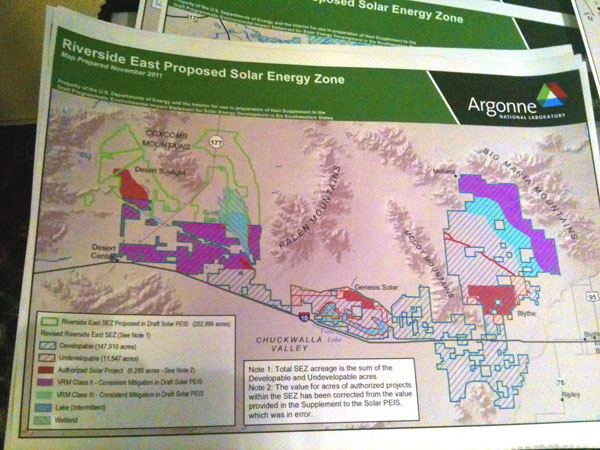
Public Comments
Several representatives from Lincoln County, Nevada, came to the meeting in Vegas meeting, including a county commissioner George Rowe. The county had successfully pushed for two of the three SEZs in their county removed because of the importance of grazing leases in those valleys (Delamar and East Mormon Mountain). In addition, they asked for additional parts of the Dry Lake Valley and Delamar Valley that are in Variance Zones to be placed in Exclusion. This was based on the importance of these valleys to their heritage -- "we have worked and played on these lands all our lives." They stressed working with the local residents and the counties is very important.
John Hiatt of Red Rock Audubon made a good point that this whole PEIS process is already behind and will be obsolete in five years due to the quick pace of technology and policy changes. Therefore BLM/DOE should review the PEIS every few years to keep up.
A representative of the Beatty Paiutes, Richard Arnold, made a very good comment that the entire PEIS was fatally flawed due to lack of cultural surveys over SEZs, lack of inclusion of many many tribes over several states, and how simply sending a letter in 2008 requesting information to some tribal offices does not constitute proper consultation. He talked about how important Amargosa Valley is to his Tribe, and this is in part a Solar Energy Zone in the PEIS. He said BLM just briefly described some archaeology within the boundary of the zone. But this ignores the living tradition that encompasses the entire valley outside the Solar Energy Zone -- it is all connected. He said Amargosa Valley was the origin place of his people and is very important. Big Dune has sacred meaning which will be disrupted by solar development. The whole area is a songscape, a storyscape, and this is not considered in the Cultural Resource analysis of the PEIS. He said they did very little cultural surveys on the zone.
Representatives of Basin and Range Watch made comments: the proposed action/preferred alternative which grants SEZ’s and still allows standard business as usual on other BLM lands (the Variance Process). For alternatives, NEPA requires that alternatives outside of the jurisdiction of the lead agency need to be considered. Those would be the 1 million acres of brownfields identified by the EPA, and distributed generation. A DG alternative makes sense due to the fact that large-scale solar trends are for photovoltaic power plants due to the dumping of cheap Chinese panels on the US market. PV gets more bang for the buck used on rooftops without the inefficient and pricey transmission lines.
The last public comment made was by Don Reid, the developer of Amargosa Farm Road Solar Project (formerly Solar Millennium). He was angry that transmission was the key that the PEIS was still not integrating into the big picture. He said -- "Is there a plan for regional transmission? We can set up these zones, but there is no coordination to get to the biggest market in California." He ended by saying about the PEIS, "What are we talking about, a wish?"
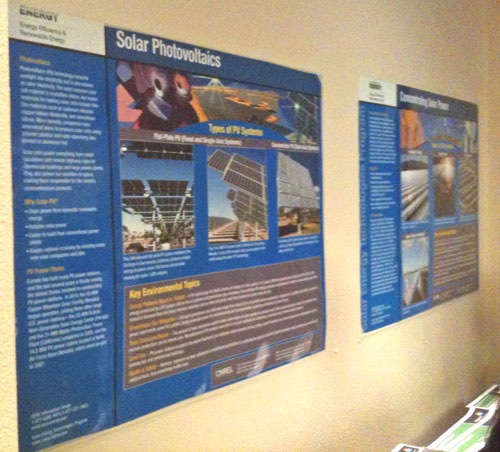
The elephant in the room was transmission. The PEIS may be heading for a different direction due to the lack of transmission to many remote Solar Energy Zone proposals that are quite far from load centers. The room was full of solar developers and their attorneys such as First Solar and Solar Reserve. They don't like most of the SEZs because they are too remote and no transmission, so the pressure is on BLM to correct this mistake. There may be a push to designate new zones quickly along the major transmission lines being built, upgraded, or soon to happen such as Ivanpah-Eldorado, Pisgah-Lugo, South of Kramer, ON line, Sunrise Powerlink, Devers-Palo Verde, Hidden Hills Transmission Project, Tehachapi Renewable Transmission Project, and others. Desert ecosystems? We'll figure out a way to mitigate them somehow later on.
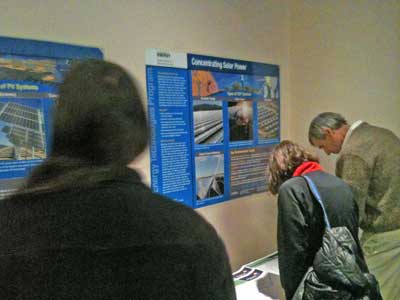

Register to Speak
November 28, 2011 - Click here to register to speak at one of the four public meetings coming up this week for the Supplement to the Solar Programmatic Environmental Impact Statement.
These meetings will be in Las Vegas, Nevada on November 30; Phoenix, Arizona on December 1; El Centro, California on December 7; and Palm Desert California on December 8. All meetings start at 7:00 p.m. One problem is that this PEIS affects public lands in 6 states but meetings will only be held in three states. Ask for alternatives that site solar on Environmental Protection Agency identified degraded lands or “brownfields” and of course Distributed Generation. Under the National Environmental Policy Act (NEPA), the Bureau of Land Management is still required to consider alternatives outside of the jurisdiction of the lead agency. Under orders from Interior Secretary Salazar, BLM has attempted to shy away from this requirement, but NEPA has not been changed. Keep insisting that they follow NEPA.
http://solareis.anl.gov/involve/pubschedule/index.cfm
Supplement to Draft Solar PEIS Released
October 27, 2011 - The Department of Interior released a Supplement today to the giant Solar Programmatic Environmental Impact Statement (PEIS), that still allows solar developers to choose any of 22 million acres of public land managed by Bureau of Land Management to build a power plant. The changes respond to over 80,000 comments on the Draft PEIS.
First released for public review in December, 2010, the Solar PEIS will establish a framework for developing large utility-scale solar energy projects on public lands, based on landscape-level planning and the best available science (according to the Department of Interior), designed to promote the development in “solar energy zones” in six western states. The supplement is targeted at addressing several key issues identified through public comments and providing a number of enhancements, including developing a well defined process for identifying solar energy zones; incentives for encouraging developers to site their projects in the zones and a variance process for those who wish to develop facilities outside of the zones; additional surveys for biological and cultural resources in the zones; and a more detailed analysis of transmission.
Solar Energy Zones, Variance process, and Tortoise connectivity
The original draft Solar PEIS designated solar zones, along with advantages to companies locating in zones, including shorter reviews and the ability to contribute to landscape-scale mitigation programs for each zone, as opposed to developing mitigation individually for each project. But there is still a provision for some exceptions called “variance applications.” In these, the burden will be on the companies to prove their proposed project site is low conflict; costs including preparing environmental reviews will be greater; and Interior spokespeople stressed that “these will be the exception rather than the
rule.” But this variance process allows solar companies to continue to choose any land in the 20 million acres of public lands, and does not truly limit renewable energy development to zones.
The variance would exclude future utility scale solar development on some lands. Ironically, the Ivanpah Valley is part of an identified tortoise connectivity corridor that -- if the variance is adopted -- would discourage solar energy development. The variance would also require that projects built outside of designated tortoise connectivity corridors to still require a corridor three miles wide for connectivity.
From the supplement: For all applications in variance areas within the range of desert tortoise and within proposed connectivity areas (see red hatched areas in Figure 2.2-2), siting will be discouraged given anticipated high conflict.
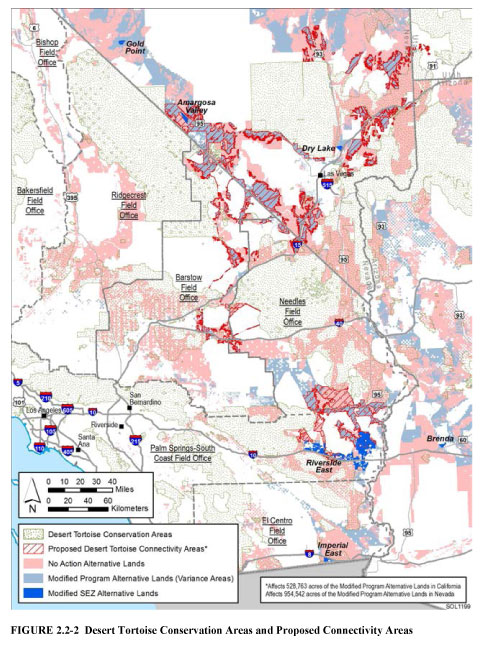
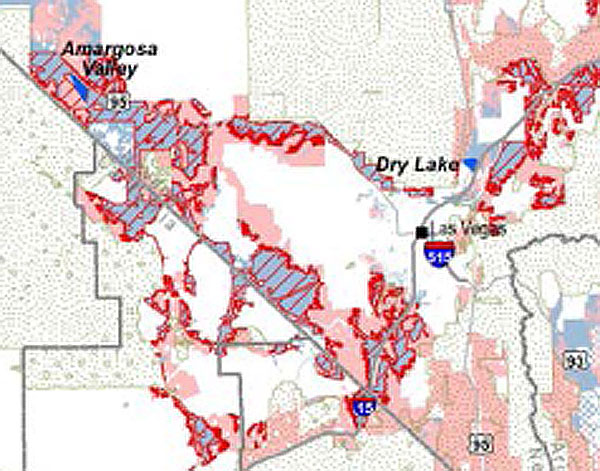
^Detail showing the tortoise connectivity zones (in red crosshatch) proposed in the PEIS, but notice the blue Variance Areas filling most of the tortoise valley habitats, where solar applicants can still chose to locate. These blue zones allowing development push the tortoise connectivity to narrow edges of the basins, eliminating the function of the connectivity habitat. Tortoises need wide areas for connectivity that serve as permanent habitat.
Some Zones eliminated, including Pisgah and Iron Mountain in California
From 24 proposed zones, the number has been reduced to 17, some because they
were stranded with no transmission, others because of "high environmental
conflicts" -- which we feel applies to all proposed zones. The overall acreage in zones has been reduced from 677,000 to 285,000. Interior’s stated long-term objective is to have all the zones well characterized or studied, such that companies can tier off that data and thus shorten applications’ cost and time; however, they have signaled that projects
may still need to do individual environmental reviews. A specific set of criteria has been identified to select zones with emphasis on "low conflict, low environmental/cultural and
historic impacts."
California:
Pisgah
From the PEIS: Although the area will be dropped from consideration as an SEZ, most of the lands that composed the proposed Pisgah SEZ will be retained as solar right-of-way variance areas, because the BLM expects that individual projects could be sited in this area to avoid and/or minimize impacts. Any solar development within this area in the future would require appropriate environmental analysis. An exception to the above will be made for specific lands identified during the environmental review process for the approved Calico Solar Project (CACA 49537), which comprises more than 4,600 acres (19 km2) within the SEZ. Through the Calico environmental review process, some parts of the project area were identified as areas where solar development should be avoided; these areas will now be identified as solar right-of-way exclusion areas, that is, areas where applications for solar development will not be accepted by the BLM.
Iron Mountain
This basin held an historic airfield and camp used by General Patton for training maneuvers preparing for World War II. Many national environmental groups opposed this zone due to its proximity to five Wilderness Areas, and inclusion in the proposed new desert monument as part of the (stalled) California Desert Protection Act of 2010. We note that many historic Patton training relicts are also found in other zones which have been kept, such as Riverside. Also, Wilderness Areas overlook other zones as well which were not opposed by groups. Only this dropped zone has been designated as a solar exclusion zone for any future development.
Arizona:
Bullard Wash
From the PEIS: Although the area will be dropped from consideration as an SEZ, the lands that composed the proposed Bullard Wash SEZ will be retained as solar right-of-way variance areas, because the BLM expects that individual projects could be sited in this area to avoid and/or minimize impacts. Any solar development within this area in the future would require appropriate environmental analysis.
Bullard Wash, in southwestern Yavapai County, had local environmental groups say that solar plants would disturb a delicate transition zone between a Joshua tree woodland and the Sonoran Desert with saguaro cacti.
“There is a unique flora and fauna where you have overlap,” in the Bullard Wash region, said Greta Anderson, deputy director of the Western Watersheds Project. “The connectivity and expansion of species in either direction is very important.” (quoted in Cronkite News)
Nevada:
Delamar Valley
From the PEIS: Although the area will be dropped from consideration as an SEZ, the lands that composed the proposed Delamar Valley SEZ will be retained as solar ROW variance areas, because the BLM expects that individual projects could be sited in this area to avoid and/or minimize impacts. Any solar development within this area in the future would require appropriate environmental analysis.
East Mormon Mountain:
From the PEIS: Although the area will be dropped from consideration as an SEZ, the lands that composed the proposed East Mormon Mountain SEZ will be retained as solar right-of-way variance areas, because the BLM expects that individual projects could be sited in this area to avoid and/or minimize impacts. Any solar development within this area in the future would require appropriate environmental analysis.
New Mexico:
Mason Draw
Although the area will be dropped from consideration as an SEZ, the lands that composed the proposed Mason Draw SEZ will be retained as solar right-of-way variance areas, because the BLM expects that individual projects could be sited in this area to avoid and/or minimize impacts. Any solar development within this area in the future would require appropriate environmental analysis.
Red Sands
Although the area will be dropped from consideration as an SEZ, the lands that composed the proposed Red Sands SEZ will be retained as solar right-of-way variance areas, because the BLM expects that individual projects could be sited in this area to avoid and/or minimize impacts. Any solar development within this area in the future would require appropriate environmental analysis.
In addition, the following SEZs have been substantially reduced in size: Riverside East in California; De Tilla Gulch, Fourmile East, and Los Mogotes East in Colorado; Amargosa Valley, Dry Lake, and Dry Lake Valley North in Nevada; and Afton in New Mexico. The overall result of these changes has been to reduce the total number of SEZs from the 24 presented in the Draft Solar PEIS to 17 and reduce the total acreage potentially available for development in proposed SEZs from about 677,000 acres (2,740 km2) to about 285,000 acres (1,149 km2).
Areas that are excluded from any solar development
In addition to incentives to locate in zones, the program changes include a list of exclusion areas that cannot be considered for solar development. These include Areas of Critical Environmental Concern (ACECs), Desert Wildlife Management Areas (DWMAs), Research Natural Areas (RNAs), critical habitat, lands where BLM has made a commitment to preserve sensitive species (such as Mohave ground squirrel, fringe-toed lizard, and sage grouse), big game migratory corridors and winter ranges, areas with historic and cultural
resources, and many more. Table 2.2-1 in the Supplemental PEIS lists a total of 29 categories of exclusion lands. Thus, even though some variance applications will be considered, there are many categories of lands which will not be considered for solar development because they are excluded.
We note that large areas of Mojave fringe-toed lizard habitat and connectivity areas are still within Solar Energy Zones.
Process to add new zones
Proposed new solar energy zones on BLM lands may be nominated by members of the
public. Because two zones were eliminated in California and demand for renewable energy remains high, there is strong pressure for additional California zones from industry. Additional zones will be identified in the California Desert Renewable Energy Conservation Plan (DRECP) and Habitat Conservation Plan/Natural Community Conservation Planning (California Department of Fish and Game) process and a new zone in the Chocolate Mountains is already going forward. The West Chocolate Mountains Renewable Energy Evaluation plan will be involved.
There will also be new zones identified through Arizona’s Restoration Design planning. The expectation is that new zones will be near infrastructure. Mitigation and long-term conservation plans for each zone will be developed by BLM in regional-scale mitigation programs, including but not limited to enhanced long-term conservation on public lands. Companies locating in zones will pay into mitigation funds to accomplish the conservation goals relevant to each zone.
Existing applications will be processed under the current program
As it completes the Solar PEIS, Interior will continue to focus on its parallel, priority initiative to process existing applications for renewable energy development on public lands with full environmental analysis and public review. In the past two years, Interior has approved 22 major renewable energy projects, including 13 commercial-scale solar energy facilities.
There are 79 applications on 685,000 acres of BLM land in the six covered states (CO, NM, AZ, UT, NV, CA). However, this “grandfathering” has the potential to lead to more badly sited projects moving forward before the zone-based program is fully established.
“Between the proposed solar energy zones, the flexible variance process, the additional state-based planning efforts, and the commitment to process pending applications, Interior is taking an ‘all-hands-on-deck’ approach to building a strong solar energy economy now and into the future,” said Deputy Secretary David J. Hayes.
Competitive leasing proposed
The Interior Department intends to initiate rulemaking on competitive leasing for solar projects as opposed to the right-of-way process.
EPA process
The PEIS mentions the Environmental Protection Agency's REAL program which identifies lands suitable for development in the BLM alternatives section (section 2).
Salazar and Chu on the Supplement
“Our partners in this effort have suggested ways to strengthen the proposed solar energy program and increase certainty regarding solar energy development on public lands,” Department of Interior Secretary Ken Salazar said. “This Solar PEIS establishes for the first time a blueprint for landscape-level planning that will help facilitate smarter siting of solar energy projects. Today’s announcement lays a solid foundation for an enduring, sustainable solar energy future for our nation.”
Interior Secretary Ken Salazar said in a conference call Thursday that the idea behind the solar zones is trying to identify “where the sweet spots are” for solar plants – where business opportunity is high and environmental impact is low.
Then, instead of waiting for a project to be proposed and determining whether it passes muster, the federal government can create tailor-made standards for companies to see before they dive in.
“We turned the old system on its head,” Salazar said.
“Tapping the vast potential of solar resources in the Western states will go a long way to diversifying the country’s energy portfolio and re-establishing our position as a clean energy leader in a global market worth trillions of dollars in the long term,” said Department of Energy Secretary Steven Chu. “Advancing the deployment of utility-scale solar projects will not only help provide clean power to local utilities, it will also drive down the cost of solar energy and create American jobs in the rapidly-growing clean energy economy."
Our response
The Bureau of Land Management "never will close the door on anything; that's the only thing that has been consistent in this whole process," said Janine Blaeloch, director of the Western Lands Project and member of Solar Done Right. "They won't put their foot down." (quoted in the Los Angeles Times)
As an example of how the PEIS still lacks adequate protection for resources, take a look at the proposed Solar Energy Study Zone in Amargosa Valley, Nevada. The Wilderness Society is supporting 32,000 acres of energy sprawl in Amargosa Valley by getting behind the solar PEIS. Their report is here: http://wilderness.org/files/TWS001%20Smart%20Solar_NV.pdf
We believe support of massive solar sprawl in the Amargosa Valley is environmentally irresponsible. They have recommended “environmentally friendlier” modifications to this zone which overlook several issues.
These are the following issues that have been missed by The Wilderness Society in their report:
Desert Tortoise: The Amargosa Valley represents a northern population of desert tortoise. Densities of tortoises are low in the valley and higher in surrounding mountains. The valley is an important connectivity zone. The population also has a genetic distinction from other desert tortoise populations. The Wilderness Society has asked for a narrow boundary surrounding the Amargosa River not really more than a mile and a half wide. They believe this will also serve as a connectivity corridor for the tortoise. Conservation biologists recommend wide connectivity corridors so generations of tortoises can actually breed and live functioning lives within these habitats. The lower the population density, the bigger the connectivity corridor should be. The 1.5 mile wide of the corridor is not consistent with the 2 square mile home range of the average adult male desert tortoise.
Rare Plants: The Wilderness Society states that the site is “generally dominated by sparse, shrubby plants that are of low value to wildlife”. The Amargosa Valley does not bloom every year due to the fact that it is in an arid region of the Mojave Desert. When there is a wet year, it blooms quite well. There are rare and endemic plants that grow along the Amargosa River channel in the Solar Energy Study Zone. Along with those plants come pollinators. It is not scientific to try to evaluate the botanical resources of an arid region based on limited visits on dry years.
Sand Transport: Developing 32,000 acres would avoid the Big Dune Area of Critical Environmental Concern, but would essentially block the source of sand that maintains habitat for four endemic dune beetles and several rare plants.
Contaminated Dust: The entire Amargosa Valley has ground radon levels three times the national average due to to atomic testing that took place for about 30 years in the past. The radon is stable in the soil now. Complete removal of the entire top soil will create contamination and dust issues which will be a threat to public health, not to mention the rest of the environment. Controlling that dust will require thousands of acre feet of water.
Water: Even with The Wilderness Society’s suggestion of using photovoltaic technology as the least water intensive solar technology, this would still pose a threat to the Death Valley Regional Aquifer that supports the endangered Devil’s Hole Pupfish and Ash Meadows National Wildlife Refuge. Each 4,000 to 5,000 acre photovoltaic facility that we have reviewed will use 1,500 to 2,000 acre feet of water for construction. For 32,000 acres that will be close to 14,000 acre feet of water in a region that is considered over-drafted by 17,000 acre feet. Plus, photovoltaic solar farms use 2 to 3 acre feet of water a year to wash dust off of the panels.
Death Valley National Park Wilderness: Amargosa valley is presently remote. Over 30,000 acres of solar panels or mirrors will be highly visible from a large portion of the Death Valley National Park Wilderness. Industrial development will be highly visible in both the day time and the night time.
Transmission: At this point, there is no transmission to hook up to in Amargosa Valley. Any new transmission is at least five years down the road.
Distributed Generation alternative
Project Amp, rapid growth of solar leasing opportunities, adoption of solar technology by schools, DG projects on military bases, all show that DG is a practical reality that is largely ignored by the Administration's renewable energy policies. The price drop of polysilicon photovoltaic panels that has occurred this year means that siting can be modular in smaller spaces, with no need for large installations since each panel produces exactly the same amount of power no matter where it is placed.
Thanks to their generous Feed-in-Tariffs cloudy Germany installed about 6,150 MW of rooftop solar in 2010, which is more than one third of the total PV installed in the world that year (source: PV Tech).
In short, Ceal Smith of Renewable Community Alliance and Solar Done Right, says the PEIS is:
* Still wrong from the start, ecologically valuable public resources should be LAST, not first resort.
* Working backwards, the EPA brownfields and contaminated lands plan should be second choice, while DG should be first.
* Misses that pricey transmission is still the big problem to accessing these remote SEZs. Remote siting incurs unacceptable transmission cost and losses.
* No logic to the endorsement by some groups that we "must destroy species and habitat now in order to save them in the future."
* Cumulative impacts are completely ignored, as well as many other assaults on our lands: private projects, transmission, other energy development (oil and gas, uranium, precious metals, etc.). These are completely unanalyzed, and could be the collective end to America's great southwestern ecosystems.
Comments accepted
The Federal Register Notice of Availability for the Supplement begins a 90-day public comment period, after which Interior’s Bureau of Land Management (BLM) will prepare a Final Programmatic Environmental Impact Statement and Record of Decision.
Dates for public meetings:
* Las Vegas, Nevada – Wednesday, November 30, 2011 at 7:00PM: Ramada Las Vegas,
325 East Flamingo Road, Las Vegas, NV 89169
* Phoenix, Arizona – Thursday, December 1, 2011 at 7:00 PM: Sheraton Crescent
Hotel, 2620 West Dunlap Avenue, Phoenix, AZ 85021
* El Centro, California – Wednesday, December 7, 2011 at 7:00 PM: Fairfield
Inn, 503 East Danenberg Drive, El Centro, CA 92243
* Palm Desert, California – Thursday, December 8, 2011 at 7:00 PM: Best Western
Hotel, 74695 Highway 111, Palm Desert, CA 92260
See the Supplement here: http://solareis.anl.gov/documents/supp/index.cfm
Some news articles:
Bureau of Land Management Press Release - http://www.blm.gov/wo/st/en/info/newsroom/2011/october/NR_10_27_2011.html
http://www.latimes.com/news/local/la-me-solar-desert-20111028,0,7889585.story?track=rss
Public Comment Period for Draft Solar PEIS Extended

The Office of Energy Efficiency and Renewable Energy (EERE), Department of Energy (DOE); and the Bureau of Land Management (BLM), Department of the Interior (DOI), are preparing a Programmatic Environmental Impact Statement (PEIS) to evaluate utility-scale solar energy development, to develop and implement Agency-specific programs or guidance that would establish environmental policies and mitigation strategies for solar energy projects, and to amend relevant BLM land use plans with the consideration of establishing a new BLM Solar Energy Program.
On March 7, 2011, the Bureau of Land Management (BLM) announced a 30-day extension of the public comment period for the Draft Solar Programmatic Environmental Impact Statement (Draft Solar PEIS), a joint effort with Department of Energy. The comment period has been extended 30 days beyond the original closing date of March 17, 2011, meaning that comments will now be accepted through April 16, 2011.
Additional information about the extension is available on the Solar PEIS Web site at http://solareis.anl.gov/news/index.cfm
To learn more about how you can participate in the PEIS process, visit the "Getting Involved" page of the Solar Energy Development PEIS Web Site
(http://solareis.anl.gov/involve/index.cfm)
If you have questions or need more information, contact the Solar Energy Development PEIS Webmaster at solareiswebmaster@anl.gov.
http://solareis.anl.gov/documents/docs/SolarDPEIS_CommentExtensionPressRelease.pdf
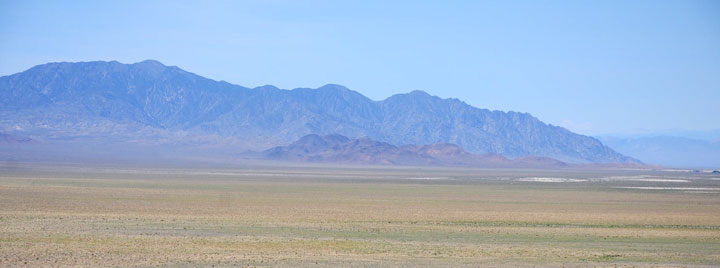
^Millers Solar Energy Zone in west-central Nevada, on the flat desert below Lone Mountain.
Big Solar's Footprint on Public Lands
[Excerpt]
By Janine Blaeloch, Western Lands Project and Solar Done Right, March 6, 2011.
In announcing the Fast Track policies, Secretary Salazar stated in late 2009 that the Interior Department had identified 23 million acres of public land with solar energy potential.
The next big step for solar development on public lands is planned to come out of the Solar Study Areas initiative, another one of the components of Interior's Fast-Track policy.
Separate from the active projects [of 2010], the BLM Solar Programmatic Environmental Impact Statement (PEIS) is a special planning-level project conducted under the National Environmental Policy Act (NEPA) that is looking at areas of BLM land with high solar potential and characteristics conducive to utility-scale solar plant development. Leading up to the issuance of the Draft PEIS, all accounts of its purpose indicated that the intent was to identify the best areas for “solar energy zones” to be established, to analyze the potential environmental impacts of large-scale solar projects, and to propose standard mitigation requirements projects must meet. The selection of lands to be carried forward as established Solar Energy Zones (SEZs)—where solar applications would receive priority status over other uses— was supposed to ensure the exclusion of lands with environmental or other conflicts, such as endangered species habitat, visually sensitive areas, wildlife corridors, cultural sites, etc.
Prior to the release of the draft EIS, maps of the Solar Study Areas (SSAs), potential SEZs, were provided to the public, encompassing 24 land tracts in Arizona, California, Nevada, New Mexico, Utah, and Colorado. The areas with the most land under consideration lie in the Mojave, Colorado, and Sonoran deserts of California, Arizona, and Nevada.
The original, mapped SSAs comprised a total of 676,000 acres. It was anticipated that through public input and further analysis, the acreage under consideration would be substantially reduced as environmental or other conflicts were identified, and that the overall goal was to steadily eliminate areas and focus acutely on lands most suitable for industrial-scale solar development.
Against all expectations, however, the Draft PEIS, released in mid-December 2010, identified a Preferred Alternative called the Solar Energy Development Program Alternative, keeping 21.5 million acres available for solar applications, coinciding closely with the total amount of BLM land thought to have solar potential. The selection of this alternative signaled that Interior was not willing to limit the amount of land under consideration, and was accommodating the industry's demands for this flexibility.
In their joint scoping letter for the draft PEIS, three industry groups—the Large-scale Solar Association, Solar Energy Industries Association, and Center for Energy Efficiency and Renewable Technologies—had asked that much more land be added for consideration, and had provided a list of specific areas and types of public land that should be available for right-of-way applications. “It is critical that the 24 already-designated [Solar Energy Study Areas] do not become a prescriptive constraint on utility-scale solar energy development,” the letter said.
With the Preferred Alternative now encompassing 21.5 million acres, the SSAs became the Solar Energy Zone Program Alternative, with 677,384 acres.
The choice of the multi-million-acre Preferred Alternative has caused considerable consternation in the environmental community. For the most part, the national environmental organizations support the concept, and most of the particulars, of the SEZ Program Alternative, and are recommending that the BLM choose that alternative, with some changes. Others, however, are calling for consideration of a much broader range of alternatives that would include prioritizing distributed generation in the built environment (e.g. rooftop solar), and secondarily, projects sited only on degraded or previously developed public land.
Ultimately, not all of the public lands being eyed for industrial solar development will be exploited for this use. Yet, while driven by the real need to develop renewable energy, policymakers are clearly not giving adequate consideration to the consequences of turning public lands into an energy factory. It is essential that we not lose sight of the environmental impact and virtual privatization of public lands that could result from a heedless pursuit of remote, industrial-scale solar development.
From: http://solardoneright.org/index.php/briefings/post/industrial-scale_solar_on_our_public_lands/

^Desert ironwood trees in Chuckwalla Valley, California, near the McCoy Mountains. These trees are in Riverside East Solar Energy Zone and would have to be bulldozed if large-scale solar plants were built here.
Draft Solar Programmatic Environmental Impact Statement Out
December 17, 2010 - The Draft Solar Programmatic Environmental Impact Statement, was compiled over the past two years as part of the Obama Administration’s efforts to create a framework for developing renewable energy "in the right way and in the right places" was released yesterday. The public has a 90-day comment period.
 “This proposal lays out the next phase of President Obama’s strategy for rapid and responsible development of renewable energy on America’s public lands,” Secretary Salazar said. “This analysis will help renewable energy companies and federal agencies focus development on areas of our public lands that are best suited for large-scale solar development. Our early, ‘Smart from the Start,’ planning will help us site solar projects in the right places, and reduce conflicts and delays at later stages of the development process.”
“This proposal lays out the next phase of President Obama’s strategy for rapid and responsible development of renewable energy on America’s public lands,” Secretary Salazar said. “This analysis will help renewable energy companies and federal agencies focus development on areas of our public lands that are best suited for large-scale solar development. Our early, ‘Smart from the Start,’ planning will help us site solar projects in the right places, and reduce conflicts and delays at later stages of the development process.”
“Our country has incredible renewable resources, innovative entrepreneurs, a skilled workforce, and manufacturing know-how,” said Energy Secretary Steven Chu. “It’s time to harness these resources and lead in the global clean energy economy. Today’s announcement is part of an integrated strategy to cultivate the entire innovation chain to create the jobs of the 21st century economy and to put America on a sustainable energy path.”
The Draft Solar Programmatic Environmental Impact Statement (PEIS) assessed the environmental, social, and economic impacts associated with solar energy development on Bureau of Land Management (BLM) administered areas in Arizona, California, Colorado, Nevada, New Mexico, and Utah.
Under the study’s Preferred Alternative, the BLM would establish a new Solar Energy Program that would standardize and streamline the authorization process and establish mandatory design features for solar energy development on BLM lands.
Yet in addition to these zones, millions of acres of additional BLM land would also be opened up for solar applications, which leads us to ask how this document will change the situation of a Solar Gold Rush from today? Even a large document such as this cannot specify in enough detail the variable characteristics of 22 million acres of public land in six states.
On the basis of these exclusions, about 22 million acres of BLM-administered lands would be available for right of way applications for solar development under the Preferred Alternative. That includes about 677,400 acres identified as proposed Solar Energy Zones.
The preferred method of commenting on the Draft Solar PEIS is by written submissions using the online form available at http://solareis.anl.gov. Comments can also be mailed to: Solar Energy Draft Programmatic EIS, Argonne National Laboratory, 9700 S. Cass Avenue - EVS/240, Argonne, Illinois 60439. Comments may also be submitted at public meetings scheduled for California: Barstow, El Centro, Ontario, and Palm Springs; Colorado: Alamosa; Nevada: Caliente, Goldfield, Las Vegas; Utah: Cedar City and Salt Lake City; New Mexico: Las Cruces; Arizona: Phoenix and Tucson; and Washington, D.C. in February and March 2011.
The Draft Solar Energy PEIS document is available online at the project website: http://solareis.anl.gov. Maps are available at http://blm.gov/td5c.
HOME.....Solar Done Right.....Our Comments
